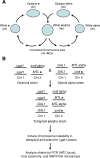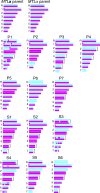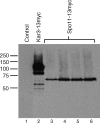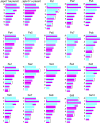The parasexual cycle in Candida albicans provides an alternative pathway to meiosis for the formation of recombinant strains
- PMID: 18462019
- PMCID: PMC2365976
- DOI: 10.1371/journal.pbio.0060110
The parasexual cycle in Candida albicans provides an alternative pathway to meiosis for the formation of recombinant strains
Abstract
Candida albicans has an elaborate, yet efficient, mating system that promotes conjugation between diploid a and alpha strains. The product of mating is a tetraploid a/alpha cell that must undergo a reductional division to return to the diploid state. Despite the presence of several "meiosis-specific" genes in the C. albicans genome, a meiotic program has not been observed. Instead, tetraploid products of mating can be induced to undergo efficient, random chromosome loss, often producing strains that are diploid, or close to diploid, in ploidy. Using SNP and comparative genome hybridization arrays we have now analyzed the genotypes of products from the C. albicans parasexual cycle. We show that the parasexual cycle generates progeny strains with shuffled combinations of the eight C. albicans chromosomes. In addition, several isolates had undergone extensive genetic recombination between homologous chromosomes, including multiple gene conversion events. Progeny strains exhibited altered colony morphologies on laboratory media, demonstrating that the parasexual cycle generates phenotypic variants of C. albicans. In several fungi, including Saccharomyces cerevisiae and Schizosaccharomyces pombe, the conserved Spo11 protein is integral to meiotic recombination, where it is required for the formation of DNA double-strand breaks. We show that deletion of SPO11 prevented genetic recombination between homologous chromosomes during the C. albicans parasexual cycle. These findings suggest that at least one meiosis-specific gene has been re-programmed to mediate genetic recombination during the alternative parasexual life cycle of C. albicans. We discuss, in light of the long association of C. albicans with warm-blooded animals, the potential advantages of a parasexual cycle over a conventional sexual cycle.
Conflict of interest statement
Figures







Comment in
-
Birds do it, bees do it, but Candida albicans does it differently.PLoS Biol. 2008 May;6(5):e121. doi: 10.1371/journal.pbio.0060121. Epub 2008 May 6. PLoS Biol. 2008. PMID: 20076710 Free PMC article. No abstract available.
References
-
- Kassir Y, Adir N, Boger-Nadjar E, Raviv NG, Rubin-Bejerano I, et al. Transcriptional regulation of meiosis in budding yeast. Int Rev Cytol. 2003;224:111–171. - PubMed
-
- Edmond MB, Wallace SE, McClish DK, Pfaller MA, Jones RN, et al. Nosocomial bloodstream infections in United States hospitals: a three-year analysis. Clin Infect Dis. 1999;29:239–244. - PubMed
-
- Ruhnke M, Maschmeyer G. Management of mycoses in patients with hematologic disease and cancer: review of the literature. Eur J Med Res. 2002;7:227–235. - PubMed
-
- Eggimann P, Garbino J, Pittet D. Epidemiology of Candida species infections in critically ill non-immunosuppressed patients. Lancet Infect Dis. 2003;3:685–702. - PubMed
Publication types
MeSH terms
Substances
Grants and funding
LinkOut - more resources
Full Text Sources
Other Literature Sources
Molecular Biology Databases

